In the world of welding, precision, and quality are paramount. Traditional Tungsten Inert Gas (TIG) welding has long been the gold standard for producing high-quality welds.
But with the rise of hybrid TIG welding, welders now have access to cutting-edge technology that combines the benefits of TIG with the speed and efficiency of other welding processes.
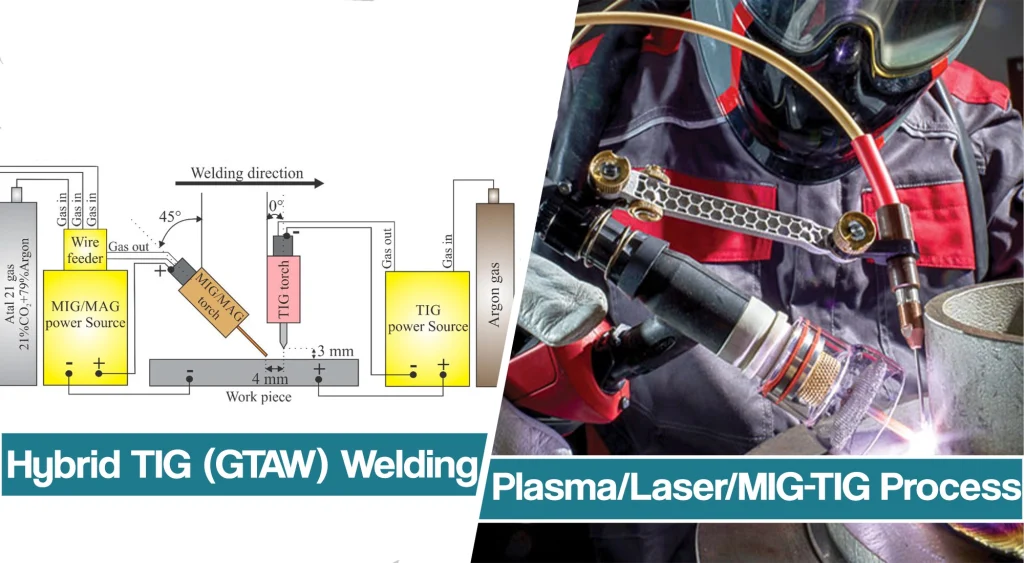
Hybrid TIG welding involves the use of a secondary heat source, such as a plasma arc or laser, to increase the welding speed while maintaining the precision and control of TIG.
This revolutionary technique has opened up new possibilities for welding in industries ranging from aerospace to automotive manufacturing.
What Is Hybrid TIG Welding?
Hybrid Tungsten Inert Gas (TIG) welding is a welding process that combines the precision and control of TIG welding with the speed and efficiency of other welding processes, such as plasma arc welding or laser welding.
In hybrid TIG welding, a secondary heat source is used to increase the welding speed while maintaining the quality and precision of TIG welding current.
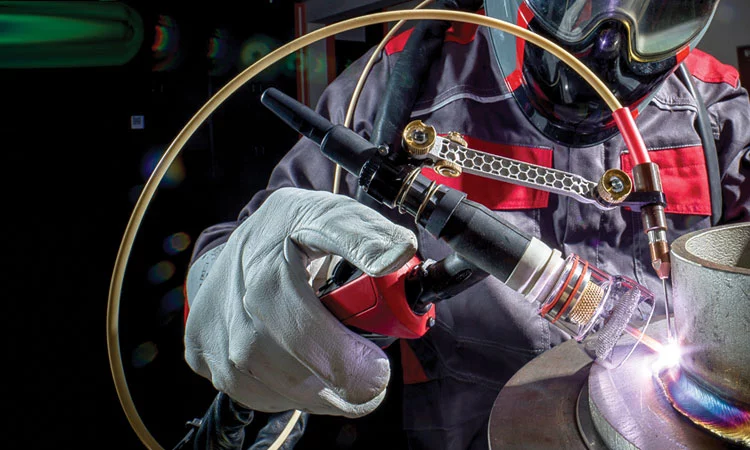
The fundamental principle of hybrid TIG welding is to use the TIG welding arc to create a highly focused and intense heat source, while simultaneously using a secondary heat source to preheat the material and provide additional heat input to the weld. The combination of the two heat sources allows for faster welding speeds without compromising the quality and integrity of the weld.
The importance of hybrid TIG welding lies in its ability to increase welding productivity while maintaining the high quality and precision that TIG welding is known for. The use of a secondary heat source can increase the welding speed by up to four times, making it an ideal process for applications that offer higher welding speed without sacrificing quality.
Applications Of Hybrid TIG Welding
Hybrid TIG welding has a wide range of applications in industries such as aerospace, automotive, and nuclear power. It is used to weld materials such as titanium, stainless steel, and aluminum, and is particularly useful for welding thin materials that require a high degree of precision.
In aerospace applications, hybrid TIG welding is used to weld critical components such as engine parts, turbine blades, and structural components. In the automotive industry, it is used to weld body panels, exhaust systems, and suspension components. In the nuclear power industry, it is used to weld components that require high precision and quality, such as fuel rods and reactor components.
Types Of Hybrid TIG Welding
There are several common types of hybrid Tungsten Inert Gas (TIG) welding processes that are used in The most common types of hybrid TIG welding processes include:
- Hybrid Plasma-TIG Welding: In this process, a plasma arc is used as the secondary heat source. The plasma arc preheats the material and provides additional heat input to the weld, allowing for faster welding speeds while maintaining high quality and precision.
- Hybrid Laser-TIG Welding: In this process, a laser is used as the secondary heat source. The laser beam preheats the material and provides additional heat input to the weld, allowing for faster welding speeds while maintaining high quality and precision.
- Hybrid MIG-TIG Welding: In this process, a Metal Inert Gas (MIG) welding process is used as the secondary heat source. The MIG process provides additional heat input to the weld, allowing for faster welding speeds while maintaining high quality and precision.
- Hybrid TIP-TIG Welding: In this process, a Tungsten Inert Gas Plasma (TIP) welding process is used as the secondary heat source. The TIP process provides additional heat input to the weld, allowing for faster welding speeds while maintaining high quality and precision.
Each of these hybrid TIG welding processes has its own advantages and disadvantages, and the choice of process will depend on the specific application requirements. However, all of these processes offer the benefit of faster welding speeds without sacrificing quality and precision.
Hybrid Plasma-TIG Welding
Hybrid Plasma-Tungsten Inert Gas (TIG) welding is a welding process that combines the precision and control of TIG welding with the speed and efficiency of plasma arc welding. In this process, a plasma arc is used as the secondary heat source, while the TIG welding arc is used to create a highly focused and intense heat source.
The process of hybrid plasma-TIG welding begins with the preparation of the material to be welded.
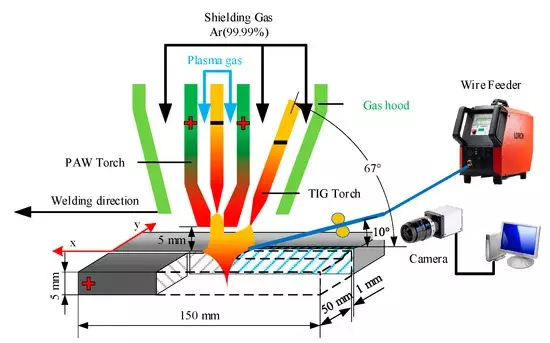
The material is first cleaned and prepped to remove any contaminants, such as oil or rust, that could affect the quality of the weld. Next, the material is clamped into place and the welding process can begin.
The TIG welding arc is initiated and used to create a precise and controlled weld pool. The plasma arc is then added to the process and used to preheat the material and provide additional heat input to the weld. The plasma arc is created by passing a gas, such as argon, through a plasma torch and applying a high voltage to the gas, ionizing it and creating a plasma arc.
Advantages of Hybrid Plasma TIG Welding
The plasma arc has several advantages over other welding processes. It can reach higher temperatures than a TIG welding arc, which allows for faster welding speeds. It can also provide more heat input to the weld, which can help to reduce the risk of defects such as porosity or lack of fusion. Additionally, the plasma arc can be used to cut or gouge the material, making it a versatile tool for welding and fabrication.
The combination of the TIG welding arc and the plasma arc in hybrid plasma-TIG welding allows for a faster welding speed while maintaining the high quality and precision of TIG welding. This process is particularly useful for welding materials such as stainless steel, aluminum, and titanium, which require a high degree of precision and control.
Hybrid Laser-TIG Welding
Hybrid laser- Arc welding with Tungsten Inert Gas welding is a welding process that combines the precision and control of TIG welding with the speed and efficiency of laser welding. In this process, a laser beam is used as the secondary heat source, while the TIG welding arc is used to create a highly focused and intense heat source.
The laser arc hybrid welding process begins with the preparation of the material to be welded.
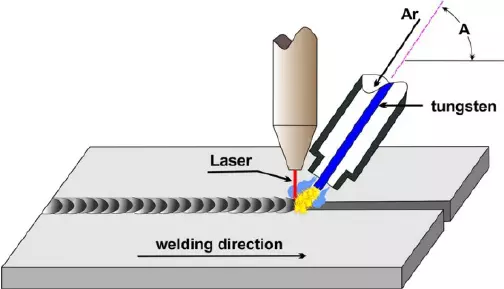
The material is cleaned and prepped to remove any contaminants, and then clamped into place. The TIG welding arc is initiated and used to create a precise and controlled weld pool. The laser beam is then added to the process and used to preheat the material and provide additional heat input to the weld. The laser beam is created by focusing a high-powered laser onto the material, which vaporizes the material and creates a localized heat source.
Hybrid laser-TIG welding is used in a variety of industries, from aerospace to medical device manufacturing. This process is particularly useful for welding materials that require a high degree of precision and control, such as thin metals and small components. It is also useful for welding dissimilar materials, such as aluminum and copper, which can be difficult to weld using traditional methods.
Advantages And Drawbacks of Hybrid Laser-TIG Welding
The combination of the TIG welding arc and the laser beam in hybrid laser-TIG welding allows for a faster welding speed while maintaining the high quality and precision of TIG welding. This process can achieve deep penetration with minimal distortion, allowing for precise and consistent welds. It also reduces the amount of heat affected zone (HAZ), which can lead to better material properties and reduced post-weld processing. Additionally, hybrid laser-TIG welding can be automated, making it an efficient and cost-effective option for high-volume production.
One of the drawbacks of hybrid laser-TIG welding is its complexity and cost. The equipment and setup required for this process can be expensive, making it less accessible to smaller businesses. Additionally, the process can be more difficult to control than traditional TIG welding, which can lead to issues such as porosity and lack of fusion. The laser beam can also be affected by surface conditions, such as reflectivity or contamination, which can impact the quality of the weld.
TIG-MIG Hybrid Welding
Hybrid MIG-Tungsten Inert Gas (TIG) welding is a welding process that combines the benefits of both MIG and TIG welding processes.
In this process, a MIG welding arc is used as the primary heat source, while the TIG welding arc is used to provide additional heat and precision to the weld.
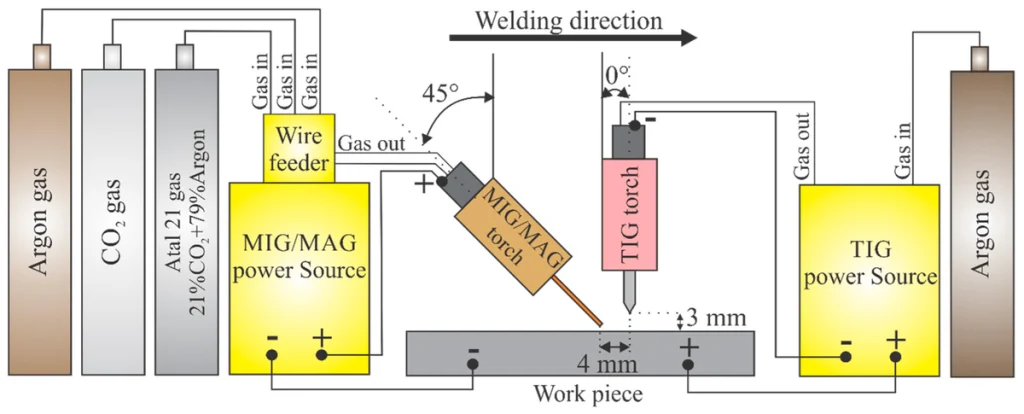
The TIG/MIG hybrid welding process begins with the preparation of the material to be welded. The material is cleaned and prepped to remove any contaminants, and then clamped into place. The MIG welding arc is initiated and used to create a weld pool. The TIG welding arc is then added to the process and used to provide additional heat and precision to the weld. The TIG arc is used to refine the weld shape, increase weld penetration, and improve weld quality.
Hybrid MIG-TIG welding is used in a variety of industries, from automotive to construction. This process is particularly useful for welding materials that require a high degree of precision and control, such as thin metals and small components. It is also useful for welding dissimilar materials, such as aluminum and steel, which can be difficult to weld using traditional methods.
Advantages And Drawbacks of Hybrid MIG-TIG Welding
The combination of the Metal Inert Gas welding arc and the Gas Tungsten Arc welding processes in hybrid MIG-TIG welding allows for a faster welding speed while maintaining the high quality and precision of TIG welding. This process can achieve deep penetration with minimal distortion, allowing for precise and consistent welds. It also reduces the amount of heat-affected zone (HAZ), which can lead to better material properties and reduced post-weld processing. Additionally, hybrid MIG-TIG welding can be automated, making it an efficient and cost-effective option for high-volume production.
One of the drawbacks of hybrid MIG-TIG welding is that it can be more difficult to control than conventional MIG welding or TIG welding. The process requires a skilled welder to adjust the welding parameters to ensure high-quality results. Additionally, the process can be more expensive than traditional MIG arc welding or TIG welding due to the equipment and setup required.
Conclusion
Hybrid welding processes offer numerous benefits and advantages over traditional welding methods, including increased efficiency, precision, and control. Hybrid welding processes such as hybrid plasma TIG welding and hybrid laser TIG welding offer unique advantages in specific applications, while hybrid MIG-TIG welding provides a versatile and efficient option for welding thick materials and dissimilar metals.
However, these processes also have their drawbacks, including increased complexity and cost, and require careful control and monitoring to ensure high-quality results. Overall, the benefits of hybrid TIG welding make it a valuable and growing field in modern welding technology.





